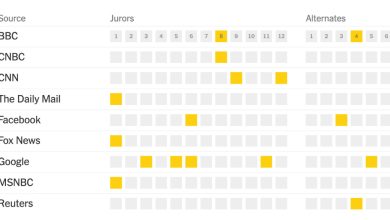He Didn’t Plan to Buy a Place on Fire Island. But This Was No Ordinary Home.

Glenn Rice’s journey to owning a house on Fire Island, N.Y., began unexpectedly in Boston and was propelled, surprisingly, by his love of theater.
In September 2017, Mr. Rice, a real estate agent, visited Boston to see a friend perform in the opening night of the play “WARHOLCAPOTE.” At a dinner afterward, he befriended Rob Roth, the playwright who wrote the show.
“We just started talking and got along like gangbusters,” said Mr. Rice, 49. “So at the end of the evening, he said, ‘You should come out and stay with me in Fire Island. I think you’ll like it.’”
The next summer, Mr. Rice took Mr. Roth up on the offer and found that he liked Mr. Roth’s getaway in the Pines very much indeed. But as he strolled along the boardwalk, it was another house that commanded his attention: a large, pyramid-shaped building with cedar shingles on three sides and a soaring triangular wall of steel and glass on the fourth.
It was almost as if a large mock-up of I.M. Pei’s Louvre Pyramid had washed up on the beach.
Intrigued, Mr. Rice began asking around and learned that the house was owned by Jeff Mahshie, a fashion and costume designer. So when Mr. Rice’s friends encouraged him to ask for a tour, he barely hesitated before walking over.

The house, which has a steel-and-glass wall like the Louvre Pyramid, was updated by Hal Hayes in the early 21st century.Credit…Genevieve Garruppo
Mr. Mahshie answered and welcomed him inside — and Mr. Rice couldn’t believe his eyes as he took in the sweeping view over sand dunes to the ocean and the bay.
“We walk in, and it’s just incredible,” Mr. Rice said.
The house was designed by Julio Kaufman, an Argentine architect, in the early 1960s. Then in 2001, the writer Paul Rudnick bought it and hired another architect, Hal Hayes, to update and expand it. It was Mr. Hayes who added the steel-and-glass wall, and who reconfigured the interior to make the top level an open living-and-dining area with a kitchen and the lower level an expansive primary suite. Outside, Mr. Hayes added a poolside guesthouse comprising three connected boxes with pyramidal roofs.
Mr. Rice marveled at the compound, engaged Mr. Mahshie in conversation about scripts he spied on tables and finally told him that he was lucky to live in such a breathtaking home.
“And he said, ‘Actually, I’m thinking of selling,’” Mr. Rice recalled.
Mr. Rice happened to be in the process of selling his Harlem brownstone, which would provide him with the funds to buy the house. Back in Manhattan, a few days later, “we met for lunch in TriBeCa and did a handshake deal,” Mr. Rice said, after agreeing to a price of $1.32 million.
“I just fell in love with the house and thought everything about it — including the process by which I was getting it — was amazing,” he said.
After closing in December 2018, he needed to furnish the home, but he was prepared for that, too: An aficionado of design, Mr. Rice runs a side business called Supervision, buying and selling vintage midcentury-modern furniture and accessories. For the living room, he brought in a pair of teak-and-cane sofas designed by Peter Hvidt and Orla Mølgaard-Nielsen in the late 1950s, plus a pair of slouchy armchairs with lacquered wood frames and blue suede upholstery from the 1970s. For the primary suite, he installed a Norwegian Westnofa rosewood bedroom set from the 1960s and vintage French resin benches with multicolored geometric bases.
“Pretty much everything is from around the same time period as the house,” Mr. Rice said. “It’s my aesthetic anyway, but it turned out that I was choosing things that fit.”
He opted not to make any big architectural changes, but the house needed extensive repairs and upgrades, from replacing rotten cedar boards outside to adding heat tape around pipes that would otherwise freeze in the winter.
“Being on Fire Island, between the ocean and the bay, is really hard on the houses,” he said. “All the salt, the constant moisture, et cetera. So every year I do a big project. I did the electrical system and the plumbing system. This fall, it’s going to be the replacement of all the doors and windows.”
In all, Mr. Rice estimated that he has spent about $400,000 restoring and maintaining the house.
He has also flipped the script on owning a summer home, spending the majority of the year on Fire Island and periodically returning to his apartment in Williamsburg, Brooklyn. When he isn’t living in the pyramid, he rents it out on Airbnb and Vrbo, where it can fetch more than $3,000 a night in the summer. “It is my primary residence,” he said, “but I do rent the house out in the high season to help defray all of the ongoing costs.”
And if he misses a few hot, sunny days in July and August, that’s OK. “Looking through that window,” he said, “no matter what the weather is — a storm, a snowstorm, a sunny day or clouds going by — is just fantastic.”
For weekly email updates on residential real estate news, sign up here. Follow us on Twitter: @nytrealestate.



